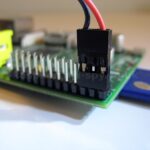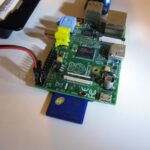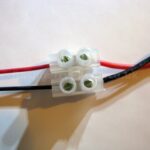- Use AA batteries as I already had lots of rechargeables and chargers
- Reduce the overall cost low by keeping additional electronics to a minimum
 After
some research I decided to buy a “UBEC”. In the Radio Controlled world
this is a “Universal Battery Eliminator Circuit” but is really just a
plain switch mode voltage regulator to everyone else. The device I
bought from eBay was £5, provided 5V from an input of 5.5V-20V and was
capable of supplying up to 3A. Perfect.
After
some research I decided to buy a “UBEC”. In the Radio Controlled world
this is a “Universal Battery Eliminator Circuit” but is really just a
plain switch mode voltage regulator to everyone else. The device I
bought from eBay was £5, provided 5V from an input of 5.5V-20V and was
capable of supplying up to 3A. Perfect. Next
I bought a battery box. 4 AAs might struggle to provide enough voltage
to the regulator so I opted for a 6xAA battery box. I already had plenty
of rechargeable AA batteries so I grabbed some Sanyo Eneloop (NiMH)
cells and charged them up. These batteries are great as unlike regular
rechargeables they hold their charge even if left for months without
use.
Next
I bought a battery box. 4 AAs might struggle to provide enough voltage
to the regulator so I opted for a 6xAA battery box. I already had plenty
of rechargeable AA batteries so I grabbed some Sanyo Eneloop (NiMH)
cells and charged them up. These batteries are great as unlike regular
rechargeables they hold their charge even if left for months without
use. The
final stage was simply connecting the battery box to the UBEC regulator
and the regulator to the Pi. The UBEC came with a 3 pin connector. I
carefully repositioned one of the pins so that they had a space between
them. This allowed the connector to plug onto the Pi’s GPIO header and
provide +5V to Pin 2 and 0V to Pin 6.
The
final stage was simply connecting the battery box to the UBEC regulator
and the regulator to the Pi. The UBEC came with a 3 pin connector. I
carefully repositioned one of the pins so that they had a space between
them. This allowed the connector to plug onto the Pi’s GPIO header and
provide +5V to Pin 2 and 0V to Pin 6.Here some photos of the basic setup I used to test my battery pack :
watch -n 60 uptimeEvery minute the Putty window refreshed. This kept the WiFi connection active and proved the Pi was still operating. When the Raspberry Pi finally ran out power the last figure displayed in the Putty window gave the total time the Pi stayed powered.
- Model A (256MB) gave 16 hours 48 minutes
- Model B (256MB Rev 2.0) gave 7 hours 15 minutes








No comments:
Post a Comment